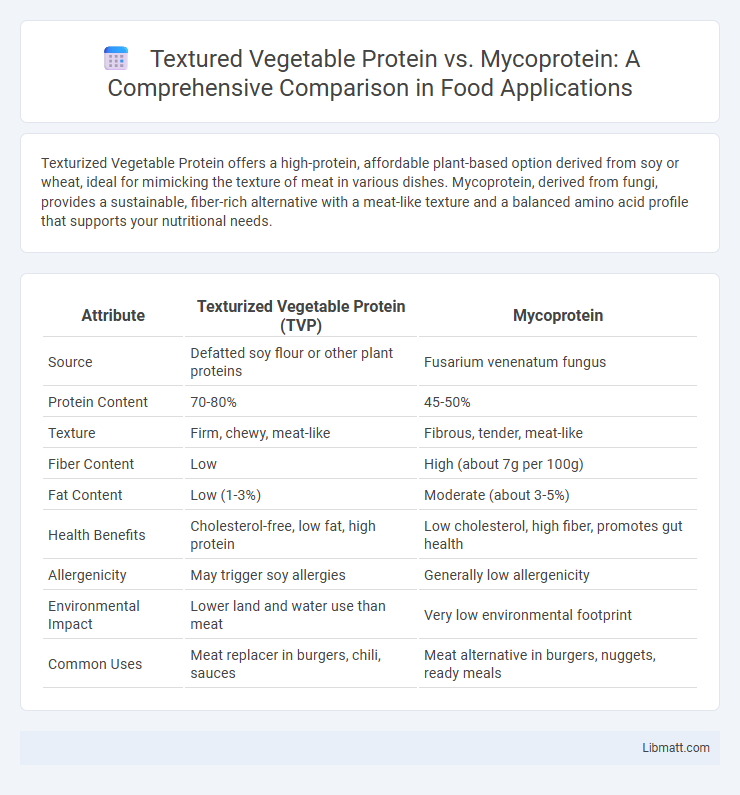Texturized Vegetable Protein offers a high-protein, affordable plant-based option derived from soy or wheat, ideal for mimicking the texture of meat in various dishes. Mycoprotein, derived from fungi, provides a sustainable, fiber-rich alternative with a meat-like texture and a balanced amino acid profile that supports your nutritional needs.
Table of Comparison
| Attribute | Texturized Vegetable Protein (TVP) | Mycoprotein |
|---|---|---|
| Source | Defatted soy flour or other plant proteins | Fusarium venenatum fungus |
| Protein Content | 70-80% | 45-50% |
| Texture | Firm, chewy, meat-like | Fibrous, tender, meat-like |
| Fiber Content | Low | High (about 7g per 100g) |
| Fat Content | Low (1-3%) | Moderate (about 3-5%) |
| Health Benefits | Cholesterol-free, low fat, high protein | Low cholesterol, high fiber, promotes gut health |
| Allergenicity | May trigger soy allergies | Generally low allergenicity |
| Environmental Impact | Lower land and water use than meat | Very low environmental footprint |
| Common Uses | Meat replacer in burgers, chili, sauces | Meat alternative in burgers, nuggets, ready meals |
Introduction to Meat Alternatives
Texturized vegetable protein (TVP) and mycoprotein stand out as leading meat alternatives, offering plant-based options rich in protein and fiber. TVP, derived from soy flour, provides a versatile, low-fat meat substitute widely used in vegan and vegetarian diets. Mycoprotein, sourced from Fusarium venenatum fungus, delivers a unique texture and high-quality protein, supporting sustainable and nutritious meal choices for your dietary needs.
What is Texturized Vegetable Protein (TVP)?
Texturized Vegetable Protein (TVP) is a high-protein, plant-based product made from defatted soy flour, created through an extrusion process that gives it a fibrous, meat-like texture. TVP is widely used as a meat substitute in vegetarian and vegan diets due to its affordability, versatility, and ability to absorb flavors well. Rich in protein and low in fat, TVP also provides a sustainable option for reducing animal product consumption.
What is Mycoprotein?
Mycoprotein is a high-protein, fungal-derived food source made from Fusarium venenatum through fermentation, commonly used as a meat substitute in products like Quorn. It contains all essential amino acids, is low in fat, and high in fiber, making it a nutritious alternative to Texturized Vegetable Protein (TVP), which is primarily made from soy or wheat. Your choice between the two may depend on dietary preferences, nutritional goals, and potential allergen sensitivities.
Nutritional Comparison: TVP vs Mycoprotein
Texturized Vegetable Protein (TVP) is rich in protein, providing approximately 50 grams per 100 grams, and contains minimal fat and carbohydrates, making it a lean source ideal for muscle building and weight management. Mycoprotein offers about 11 grams of protein per 100 grams but is also high in dietary fiber and low in saturated fat, contributing to improved digestive health and heart benefits. Your choice between TVP and mycoprotein should consider the higher protein content in TVP versus the enhanced fiber and overall nutritional profile of mycoprotein.
Texture and Culinary Applications
Texturized Vegetable Protein (TVP) offers a firm, chewy texture that closely mimics ground meat, making it ideal for dishes like chili, tacos, and burgers. Mycoprotein, derived from fungi, provides a fibrous, meat-like texture with a more tender bite, suitable for meat substitutes such as fillets, nuggets, and stir-fries. Both proteins excel in plant-based cooking but differ in their mouthfeel and preferred culinary uses based on texture profiles.
Environmental Impact and Sustainability
Texturized vegetable protein (TVP) is derived from soy or other legumes and requires less water and land compared to meat production, reducing greenhouse gas emissions significantly. Mycoprotein, made from fungi such as Fusarium venenatum, utilizes fermentation processes that consume fewer resources and generate lower carbon footprints, promoting sustainable food production. Your shift to either protein source supports efforts to minimize environmental impact and advance sustainable diets.
Allergen Concerns and Dietary Restrictions
Texturized Vegetable Protein (TVP) is derived primarily from soy, making it unsuitable for individuals with soy allergies or sensitivities, whereas Mycoprotein, sourced from fungi, may trigger reactions in people with mold or fungal allergies. TVP is typically gluten-free but can be processed in facilities that handle gluten, posing cross-contamination risks, while Mycoprotein is generally free from gluten but may not be ideal for those with yeast sensitivities. Your choice between TVP and Mycoprotein should consider specific allergen warnings and dietary restrictions to ensure safe and suitable protein intake.
Taste and Consumer Preferences
Texturized Vegetable Protein (TVP) offers a neutral, slightly nutty flavor that easily absorbs spices and sauces, making it versatile in various dishes, while Mycoprotein delivers a meatier, umami-rich taste favored by consumers seeking a more authentic meat substitute. Studies reveal that consumers often prefer Mycoprotein for its texture and flavor resemblance to traditional meat, enhancing satisfaction in plant-based diets. Your choice between the two depends on whether you prioritize customizable flavor absorption with TVP or a naturally savory profile with Mycoprotein.
Cost and Accessibility
Texturized Vegetable Protein (TVP) is generally more affordable and widely accessible due to its simple production process using defatted soy flour, making it a popular choice for budget-conscious consumers. Mycoprotein, derived from fungal fermentation, tends to be pricier and less readily available, primarily found in specialty health food stores or certain restaurants. Your choice may depend on balancing cost constraints with preferences for taste, nutritional profile, and environmental impact.
Future Prospects in Plant-Based Protein
Texturized vegetable protein (TVP) and mycoprotein represent two innovative frontiers in plant-based protein, with TVP derived from soy and other legumes, offering cost-effective, versatile meat substitutes, while mycoprotein, sourced from fungi like Fusarium venenatum, provides sustainable, high-fiber, and amino acid-rich alternatives. Market trends forecast exponential growth, driven by increasing consumer demand for environmentally friendly proteins, improved production technologies, and expanding applications in processed foods. Investment in research and development aims to enhance the sensory qualities and nutritional profiles of both proteins, positioning them as key players in the future of sustainable nutrition and food security.
Texturized Vegetable Protein vs Mycoprotein Infographic

 libmatt.com
libmatt.com